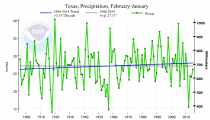We ain’t seen nothing yet: The intense drought in California is only an appetizer compared with what’s coming this century across much of the western and central USA, according to a study out last Thursday.
During the years 2050 to 2100, the Southwest and Great Plains will face a persistent “megadrought” worse than anything seen in the past 1,000 years, and the dry conditions will be “driven primarily” by human-induced global warming, scientists said.
There’s at least an 80% chance of a megadrought in these regions if climate change continues unabated, Toby Ault, an atmospheric scientist at Cornell University and co-author of the research, said at a news conference Thursday in San Jose.
A megadrought is defined as a drought that lasts for decades or longer, such as those that scorched portions of the West in the 12th and 13th centuries. Ault said megadroughts should be considered a natural hazard on par with earthquakes and hurricanes.
To identify past droughts, scientists studied tree rings to find out how much - or little - rain fell hundreds or even thousands of years ago. Scientists used that historical data in combination with 17 different computer model simulations to predict what changes we may see this century.
The computers showed robust and consistent drying in the Southwest and Plains, due to a combination of reduced precipitation and warmer temperatures that dried out the soils.
“Natural droughts like the 1930s Dust Bowl and the current drought in the Southwest have historically lasted maybe a decade or a little less,” Ben Cook, climate scientist at NASA’s Goddard Institute for Space Studies and lead author of the study, said in a statement.
-------
Icecap comments:
First the authors admit it happened before in 12th and 13th century. So such a thing is not unprecedented. Indeed, droughts have multiyear and longer variability. Instrumental data indicate that the Dust Bowl of the 1930s and the 1950s drought were the most widespread twentieth-century droughts in the United States, while tree ring data indicate that the megadroughts over the 12th Century exceeded anything in the 20th Century in both spatial extent and duration.
Second, it is based on model simulations - the same models that have failed in every projection since the 1990s. Third the drought in Texas that they said was unprecedented was nothing like the multi year drought of the 1950s. Fourth the Calfirnia drought is related to the warm water off the west coast as an after effect of the super La Nina of 2010/11 which led to cold water there and warm to the west that migrated to the west coast. It will be gone in a year and rains will return. In fact this rainy season though not the heavy wet El Nino is running near normal for rains in the northern parts of California and the Sierra though snowpack lags. There wil be more episodic rains and snows and a slow exit from the drought can be expected the next year or so.
And finally, since, the 60 year cycle max has past, and the Atlantic cooling will accelerate the PDO will resume its cold mode and the sun will continue its dive into a 200 year minimum, temperatures will cool not warm the next few decades or longer. Ironically historic megadroughts have been common in cold periods because they tend to have amplified pattern and show more persistence in the patters leading to cold and warm areas. wet and dry areas. Their models are worthess because they do not consider the oceans and sun and they projections are based entirely on radiative factors and assumptions, many of which have been shown to be wrong. Their failures prove that.







_thumb.png)